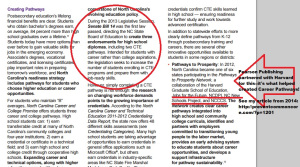Hunt Institute has a long history of being Common Core supportive.
While it appears all anti CCSS eyes are on the HR5 (the re-authorization of the NCLB), it’s been proven via documents that the HEA re-authorization is just as CCSS tied! Both have been re-authorized in almost the same time periods since their original passing in 1965. Time and time again, Sen. Lamar Alexander has been tied to the re-writing of BOTH bills. The intent? Simply put: what gets started in HR5 for CCSS, CTE, data mining, control,assessments, and educational abuse is CONTINUED into the HEA.
So what does the Hunt Institute’s announcement of 6/16/15 have to do with this? The announcement HI released, details a report published by the SREB (Southern Regional Education Board), which gives us an overview of the BRIDGE between K-12 and post-secondary..This plays right into the hands of BOTH bills being up for re-authorization. We MUST act quickly in alerting our legislators to KILL BOTH bills!! This ‘bridge’ even has a name…and I’ve taken you in great detail into the creation of that bridge. It’s called “Career Pathways”.
The Hunt Institute Announcement:
Here’s an excerpt from the HI’s website about SREB, “Labor market economists project that by 2020, two-thirds or more of all jobs will require some post-secondary education — either a certificate, a credential or a degree at the associate level or higher. At present, however, the Southern Regional Education Board’s (SREB) analyses of educational attainment data suggest that millions of young Americans are being left behind in the transition from high school to college and well-paying jobs. Significant numbers will never graduate, and many who do go on to college will never complete a credential with value in the marketplace. Credentials for All: An Imperative for SREB States, the final report of SREB’s Commission on Career and Technical Education, offers a powerful solution to this problem: Provide more than one pathway to college and careers.”
A Hunt Institute ‘Bridge’ of Their Own:
While busy promoting the SREB’s last report in a series of them, HI has produced some of its own ‘bridge’ reports for connecting K-12, post-secondary education, and alignment to the CCSS/CTE way of educating our students (remember, all ages attend post-secondary schools).
While the report I’m about to share is ‘state specific’ it can be used as evidence to research what your state may have going on that is either the same or eerily similar. Remember, the Hunt Institute has been instrumental in promoting CCSS is every state; SREB is busy promoting CCSS/CTE across several states (other regional education boards complete the coverage across the nation). (*Note: I’ve written several articles on SREB and those other regional education boards, you can find them by searching my blog, just insert the acronym for the region you wish to find.)
Hunt Institute’s series, “CoNCepts”, from their latest issue: “This issue of coNCepts examines the ways North Carolina’s K-12 and higher education systems are working together to ensure college and career readiness for all students by aligning K-12 with post-secondary expectations, creating clearly defined pathways for career training and college preparation, and forming robust partnerships with industry.” Further down the page, you’ll see: “ As part of NC Ready for Success, NCDPI has partnered with ACT to administer a series of college readiness assessments: EXPLORE (8th grade); PLAN (10th grade); and ACT (11th grade). Beginning in 2011-2012, PLAN and ACT were administered to all 10th and 11th graders free of charge. These assessments inform students, parents, and educators about the student’s current academic trajectory, as well as where further interventions and support are required.” See the screen shot below of another page from the ‘CoNCept’ issue.

To read the rest of the HI’s CCSS/CTE education reform news: CoNCept-Issue5
SREB, Southern Regional Education Board:
One of the last times I researched and wrote about the SREB designs on post-secondary education was another report from the same series as Hunt Institute refers to above. That was back in April 2015. That report’s name was ““Community Colleges in the South: Strengthening Readiness and Pathways” The report HI is promoting is titled, “Credentials for All: An Imperative for SREB States”. The new report, like it’s predecessor, has 8 strategy points laid out. I’ll not repeat the former 8 points from the April 2015 article, but I am including the link so you can read it for yourselves. You’ll also be able to see how the Gates Foundation and others are backing the SREB (you can bet the other regional education boards are just as well taken care of by the CCSS Machine). See April’s SREB article:
https://www.commoncorediva.com/2015/04/25/sic-em-saturday-using-community-colleges-for-more-core/
The latest SREB bridge connector from K-12 to post-secondary titled “Credentials for All: An Imperative for SREB States” is more of the same we’ve seen from those seeking to misguide Americans into believing all this CCSS/CTE reform is the best we can do for our students. No, it’s the best the CCSS/CTE Machine can do to undermine our country! “Credentials” includes a message to the SREB states (and those of us fighting CCSS/CTE) from the Governor of KY. Here’s an excerpt from his message, “ One of my goals as chair of SREB and its Commission on Career and Technical Education is to promote policies and practices to support strong career pathways that help more students earn industry and post-secondary credentials and obtain good jobs.”
The latest 8 action steps laid out in “Credentials” are as follows:
“1) Build bridges from high school to post-secondary education and the workplace by creating rigorous, relevant career pathways driven by labor market demand.”
2) Expect all students to graduate academically ready for both college and careers.
3) Select assessments of technical and workplace readiness standards that offer long-term value to individual students, employers and the economy; carry college credits; and are directly linked to more advanced certifications and further study.
4) Provide all high school career pathway teachers, especially new teachers from industry, with the professional development and fast-track induction programs they need to meet high academic, technical and pedagogical standards and enhance students’ academic and technical readiness for college and careers.
5) Adopt a framework of strategies to restructure low-performing high schools around rigorous, relevant career pathways that accelerate learning and prepare students for post-secondary credentials and degrees.
6) Offer early advanced credential programs in shared-time technology centers, aligning their curricula, instruction and technology with home high schools and community and technical colleges.
7) Incentivize community and technical colleges and school districts to double the percentage of students who earn certificates, credentials and degrees by setting statewide readiness standards and aligning assessment and placement measures with those standards. Other strategies: Use the senior year of high school to reduce the number of students who need remediation, retool developmental education, adopt individualized support strategies for struggling students and improve affordability.
8) Design accountability systems that recognize and reward districts, high schools, technology centers, and community and technical colleges that double the number of young adults who acquire post-secondary credentials and secure high-skill, high-wage jobs by age 25.”
How these action steps are taken in your states is something you MUST read for yourselves. It includes federal and state pressure via funding. Get the entire report by accessing it here: CredentialPlan
Remember, your state may not be an SREB one, but you can more than likely find the exact message from your regional education board or one extremely like this. Why? Because while all 50 states don’t have CCSS, every one of them, by law has Career Tech (aka Workforce). As I stated in the beginning of this article:
What starts in HR5 ends in HEA!


Thanks for all your great information!
Reblogged this on "SNIFFING OUT THE LIES OF THE PARASITIC ELITE AND DIGGING UP BONES ON THE NEW WORLD ORDER" NEGDOG.COM and commented:
More from The CommonCore Diva! Make Sure to listen to Wednesday & Thursday’s shows for great information about Common Core